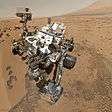Bradbury Landing
_-_HiRISE_-_20120814.jpg)
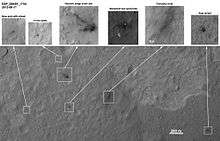
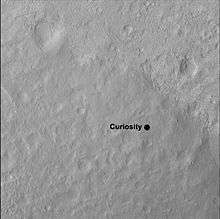
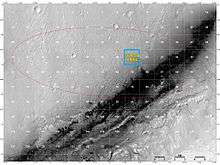
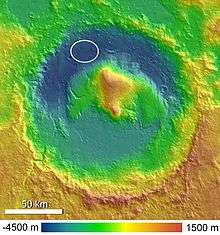
Bradbury Landing is a landing location on the planet Mars inside Gale crater. It marks the landing site of Mars Science Laboratory Curiosity rover on August 6, 2012. The location was named by NASA for Ray Bradbury on August 22, 2012, his 92nd birthday, in honor of the author who died a few months earlier, on June 5.[2][3] The coordinates of the landing site are: 4°35′22″S 137°26′30″E / 4.5895°S 137.4417°E.[4][5]
Description
Gale Crater is the MSL landing site.[6][7][8] Within Gale Crater is a mountain, named Aeolis Mons ("Mount Sharp"),[9][10][11] of layered rocks, rising about 5.5 km (18,000 ft) above the crater floor, that Curiosity will investigate. The landing site is a smooth region in "Yellowknife" Quad 51[12][13][14][15] of Aeolis Palus inside the crater in front of the mountain. The target landing site location was an elliptical area 20 by 7 km (12.4 by 4.3 mi).[16] Gale Crater's diameter is 154 km (96 mi). The final landing location for the rover was less than 2.4 km (1.5 mi) from the center of the planned landing ellipse, after a 563,000,000 km (350,000,000 mi) journey.[17]
The landing site contains material washed down from the wall of the crater, which will provide scientists with the opportunity to investigate the rocks that form the bedrock in this area. The landing ellipse also contains a rock type that is very dense, very brightly colored, and unlike any rock type previously investigated on Mars. It may be an ancient playa lake deposit, and it will likely be the mission's first target in checking for the presence of organic molecules.[18]
A rock outcrop near the landing site has been named "Goulburn". This rock outcrop, along with several others further eastward, including "Link" and "Hottah", suggest the "vigorous" flow of water in an ancient streambed.[19][20][21]
An area of top scientific interest for Curiosity lies at the edge of the landing ellipse and beyond a dark dune field. Here, orbiting instruments have detected signatures of both clay minerals and sulfate salts.[22] Scientists studying Mars have several hypotheses about how these minerals reflect changes in the Martian environment, particularly changes in the amount of water on the surface of Mars. The rover will use its full instrument suite to study these minerals and how they formed. Certain minerals, including the clay and sulfate-rich layers near the bottom of Gale's mountain, are good at latching onto organic compounds—potential biosignatures—and protecting them from oxidation.[23]
Two canyons were cut in the mound through the layers containing clay minerals and sulfate salts after deposition of the layers. These canyons expose layers of rock representing tens or hundreds of millions of years of environmental change. Curiosity may be able to investigate these layers in the canyon closest to the landing ellipse, gaining access to a long history of environmental change on the planet. The canyons also contain sediment that was transported by the water that cut the canyons;[24] this sediment interacted with the water, and the environment at that time may have been habitable. Thus, the rocks deposited at the mouth of the canyon closest to the landing ellipse form the third target in the search for organic molecules.
On March 27, 2015, NASA reported the landing site was fading from view in the two-and-a-half years since landing in 2012, as shown in the following animation:

Ray Bradbury
On naming the location, Michael Meyer, NASA program scientist for Curiosity, said "This was not a difficult choice for the science team. Many of us and millions of other readers were inspired in our lives by stories Ray Bradbury wrote to dream of the possibility of life on Mars."[2] Bradbury wrote a collection of stories called The Martian Chronicles in the 1940s.[2] The Curiosity team left a message on Twitter "In tribute, I dedicate my landing spot on Mars to you, Ray Bradbury. Greetings from Bradbury Landing!"[2] As part of the naming, NASA released a video of Bradbury from 1971 reading his poem "If Only We Had Taller Been" which is about the human quest to explore space.[25][26]

See also
References
- ↑ Amos, Jonathan (August 7, 2012). "Nasa's Curiosity rover pictured on Mars by MRO satellite". BBC News. Retrieved August 7, 2012.
- 1 2 3 4 Flood, Alison (23 August 2012). "Curiosity Martian landing point named after Ray Bradbury". The Guardian. London. Retrieved 23 August 2012.
- ↑ Brown, Dwayne; Cole, Steve; Webster, Guy; Agle, D.C. (August 22, 2012). "NASA Mars Rover Begins Driving at Bradbury Landing". NASA. Retrieved August 22, 2012.
- ↑ MSNBC Staff (August 6, 2012). "Video from rover looks down on Mars during landing". MSNBC. Retrieved October 7, 2012.
- ↑ Young, Monica (August 7, 2012). "Watch Curiosity Descend onto Mars". SkyandTelescope.com. Retrieved October 7, 2012.
- ↑ Webster, Guy; Brown, Dwayne (July 22, 2011). "NASA's Next Mars Rover To Land At Gale Crater". NASA JPL. Retrieved July 22, 2011.
- ↑ Chow, Dennis (July 22, 2011). "NASA's Next Mars Rover to Land at Huge Gale Crater". Space.com. Retrieved July 22, 2011.
- ↑ Amos, Jonathan (July 22, 2011). "Mars rover aims for deep crater". BBC News. Retrieved July 22, 2011.
- ↑ Agle, D. C. (March 28, 2012). "'Mount Sharp' On Mars Links Geology's Past and Future". NASA. Retrieved March 31, 2012.
- ↑ Staff (March 29, 2012). "NASA's New Mars Rover Will Explore Towering 'Mount Sharp'". Space.com. Retrieved March 30, 2012.
- ↑ NASA Staff (March 27, 2012). "'Mount Sharp' on Mars Compared to Three Big Mountains on Earth". NASA. Retrieved March 31, 2012.
- ↑ NASA Staff (August 10, 2012). "Curiosity's Quad - IMAGE". NASA. Retrieved August 11, 2012.
- ↑ Agle, DC; Webster, Guy; Brown, Dwayne (August 9, 2012). "NASA's Curiosity Beams Back a Color 360 of Gale Crate". NASA. Retrieved August 11, 2012.
- ↑ Amos, Jonathan (August 9, 2012). "Mars rover makes first colour panorama". BBC News. Retrieved August 9, 2012.
- ↑ Halvorson, Todd (August 9, 2012). "Quad 51: Name of Mars base evokes rich parallels on Earth". USA Today. Retrieved August 12, 2012.
- ↑ Amos, Jonathan (June 12, 2012). "Nasa's Curiosity rover targets smaller landing zone". BBC News. Retrieved June 12, 2012.
- ↑ "'Impressive' Curiosity landing only 1.5 miles off, NASA says". CNN. 14 August 2012. Retrieved 20 August 2012.
- ↑ "Context of Curiosity Landing Site in Gale Crater". NASA. July 22, 2011. Retrieved December 9, 2011.
- ↑ Brown, Dwayne; Cole, Steve; Webster, Guy; Agle, D.C. (September 27, 2012). "NASA Rover Finds Old Streambed On Martian Surface". NASA. Retrieved September 28, 2012.
- ↑ NASA (September 27, 2012). "NASA's Curiosity Rover Finds Old Streambed on Mars -video (51:40)". NASAtelevision. Retrieved September 28, 2012.
- ↑ Chang, Alicia (September 27, 2012). "Mars rover Curiosity finds signs of ancient stream". AP News. Retrieved September 27, 2012.
- ↑ "Canyons on Mountain Inside Gale Crater". NASA. November 10, 2011. Retrieved December 9, 2011.
- ↑ Webster, Guy; Dwayne Brown (July 22, 2011). "NASA's Next Mars Rover to Land at Gale Crater". NASA. Retrieved July 27, 2012.
- ↑ "Lower Portion of Mound Inside Gale Crater". NASA. July 22, 2011. Retrieved December 9, 2011.
- 1 2 Jessie Lendennie, ed. (2006). "If Only We Had Taller Been". Daughter and Other Poems. Salmon Publishing. pp. 57–58.
- ↑ "Curiosity Landing Site Named for Ray Bradbury". NASA. August 22, 2012. Retrieved August 24, 2012.
External links
| Look up Bradbury Landing in Wiktionary, the free dictionary. |
| Wikimedia Commons has media related to Gale Crater. |
- Bradbury Landing - Martian Vistas August 19, 2012.
- Bradbury Landing - Curiosity Rover 360° Panorama, August 8, 2012.
- Bradbury Landing - Curiosity Rover 3-D Panorama, August 18, 2012.
- "Curiosity Rover Lands", NASA/JPL Video (03:40), August 6, 2012.
